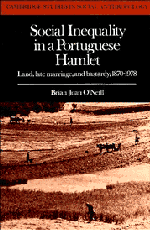Book contents
- Frontmatter
- Contents
- List of tables
- List of figures
- List of illustrations
- List of plates
- Acknowledgements
- 1 An ‘egalitarian’ Iberian community?
- 2 Open fields and communal land
- 3 Social groups
- 4 Cooperative labour
- 5 Matrimony and patrimony
- 6 Minimal marriage
- 7 The fulcrum of inheritance
- 8 Conclusion
- Appendix I The landholding survey
- Appendix II Social groups in 1851 and 1892
- Appendix III The Parish Register
- Appendix IV Household structure, 1977
- Appendix V Baptisms of bastards, 1870–1978
- Glossary of Portuguese terms
- Bibliography
- Index
- Cambridge Studies in Social Anthropology
2 - Open fields and communal land
Published online by Cambridge University Press: 11 October 2009
- Frontmatter
- Contents
- List of tables
- List of figures
- List of illustrations
- List of plates
- Acknowledgements
- 1 An ‘egalitarian’ Iberian community?
- 2 Open fields and communal land
- 3 Social groups
- 4 Cooperative labour
- 5 Matrimony and patrimony
- 6 Minimal marriage
- 7 The fulcrum of inheritance
- 8 Conclusion
- Appendix I The landholding survey
- Appendix II Social groups in 1851 and 1892
- Appendix III The Parish Register
- Appendix IV Household structure, 1977
- Appendix V Baptisms of bastards, 1870–1978
- Glossary of Portuguese terms
- Bibliography
- Index
- Cambridge Studies in Social Anthropology
Summary
This chapter deals with the various types of land cultivated in Fontelas. Firstly, I describe the major geographical characteristics of the area: aspects of the hamlet's location, climate, vegetation, and soil. Some basic features of the community's spatial organization (streets, houses, shops) are also introduced. Secondly, I look at the open-field system of rye grain cultivation, with its major features of biennial rotation and stubble-grazing. Thirdly, I examine collective rights in the hamlet's common-land, along with a number of local administrative minutes affording historical evidence of the division of small portions of common-land into individual plots. Fourthly, I provide a short description of three further types of land in Fontelas: irrigated meadows, kitchen-gardens, and vineyards. Throughout the chapter, some initial materials on the unequal distribution of land in the hamlet are set forth. These will provide a background for my subsequent analysis of land and social groups in Chapter 3.
Geographical characteristics
The terrain surrounding Fontelas is plateau land characterized by a varied topography of mountains, hills, valleys, and rivers. The concelho (municipality) in which Fontelas is located has a total area of 70,328 hectares (703.28 sq km). This area comprises both the land of the vila (municipal town) as well as that of its 34 rural freguesias (parishes). A crude average would thus yield approximately 2,000 hectares (20 sq km) of land per parish, although individual parishes and hamlets clearly vary in their total area due to variations in terrain.
The terrain of the parish of Mosteiro can be approximated at 2,400 hectares (24 sq km).
- Type
- Chapter
- Information
- Social Inequality in a Portuguese HamletLand, Late Marriage, and Bastardy, 1870–1978, pp. 23 - 69Publisher: Cambridge University PressPrint publication year: 1987



